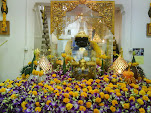A unique ceremony held in Chiang Mai every year, visitors are welcome to join in and observe. The annual rites connected with the sao inthakhin or pillar of Chiang Mai City, begin on the 13th day of the waning moon in the eighth Northern lunar moon and continue until the second day of the waxing moon of the ninth month (It is difficult to find anyone who can tell you the exact dates but it is usually sometime in June).
What is this famous Chiang Mai ceremony all about and what are its origins?
Old chronicles and modern experts have differing views. Some maintain that the lak muang or city pillar is a form of lingam and that the ceremony is a rite of fertility and rejuvenation as the rainy season begins. Others deny any phallic connotation and say that the lak muang - and many other regional Thai cities also have them - represents the centre of power of the local ruler.
The suwan kham daeng legend relates the story of the original city of Chiang Mai, which was founded by Lawa people before the birth of the Lord Buddha. At that time the city was in dead trouble, beset by demons. A certain hermit asked for help from the god Indra who gave them a protecting stone pillar and also much wealth for he knew that Chiang Mai was to become a great centre of Buddhist learning. In the course of time, however, the people came to break the taboos and the guardian kumphan demons took the pillar away whereupon disaster struck.
Again Indra was asked to help and he agreed to replace the pillar. This was the one that King Mengrai found amongst the ruins when he came to build his capital in 1296. He found out from the Lawa prince what the pillar was and how it should be propitiated. This, much altered no doubt, is the ceremony that we see today. The inthakhin is kept in a pavilion which no women are allowed to enter, in the grounds of wat chedi luang although it was not always there. If, and only if, the pillar is treated with due respect, Chiang Mai and all who live in her, will be prosperous, happy and safe.
Today the ceremony is organised by the Municipal Council together with many other groups and the Buddhist elements are stressed together with respect for authority, but nor are ancestors and the spirits of the city forgotten. An associated ceremony, pithee suab jata muang, is performed at the four city corners, the five city gates and at the Three Kings Monument, to ensure the continued long life of Chiang Mai.
Pu Sae - Ya Sae Ceremony (June)

A particularly gruesome animist ceremony still performed by some in Chiang Mai.
According to tradition, Pu Sae and Ya Sae are the guardian spirits of Chiang Mai, who now roam the slopes of Doi Suthep. The original inhabitants of this area were the Lawa who in early days are thought to have been cannibals and this is closely bound up with the Pu Sae - Ya Sae ritual as it is practised today.
Legend has it that the Lord Buddha visited Chiang Mai. These two, brother and sister, followed him with the intention of killing and eating him. The Buddha stopped and spoke to them and managed to persuade them to give up their cannibalistic ways. They pleaded with him to be allowed to eat buffalo flesh instead, even if only once a year. So it is that once a year at the beginning of the rainy season, usually in May, a buffalo is ritually sacrificed.
Formerly the Prince of Chiang Mai presided over the ceremony, which was also attended by Buddhist monks. This very ancient occasion now seems to be an attempt to bring together Shamanism and Buddhism and also to unite the Lawa people, some of whom still live in the area, and the Thais who replaced them. In the words of the Pu Sae - Ya Sae invocation, 'Let not the rice of the Lawa die in their swiddens; let not the rice of the Thai wither and die in their paddies.'
Clearly the association between Lawa and Northern Thai is both long and close.
Info & Pictures from -
http://www.chiangmainews.com/aboutchiangmai/details.php?id=21
胡



No comments:
Post a Comment